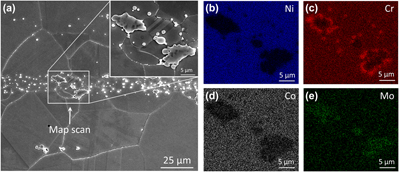Crossref Citations
This article has been cited by the following publications. This list is generated based on data provided by
Crossref.
Ding, Kai
Wang, Peng
Liu, Xia
Li, Xiaohong
Zhao, Bingge
and
Gao, Yulai
2018.
Formation of Lamellar Carbides in Alloy 617-HAZ and Their Role in the Impact Toughness of Alloy 617/9%Cr Dissimilar Welded Joint.
Journal of Materials Engineering and Performance,
Vol. 27,
Issue. 11,
p.
6027.
Zhang, Yu
Jing, Hongyang
Xu, Lianyong
Han, Yongdian
Zhao, Lei
and
Xiao, Bo
2018.
Microstructure and mechanical performance of welded joint between a novel heat-resistant steel and Inconel 617 weld metal.
Materials Characterization,
Vol. 139,
Issue. ,
p.
279.
Zhang, Yu
Jing, Hongyang
Xu, Lianyong
Han, Yongdian
Zhao, Lei
Xie, Xishan
and
Tang, Zhengxin
2019.
Fusion boundary evolution, precipitation behaviour, and interaction with dislocations in an Fe–22Cr–15Ni steel weldment during long-term creep.
Progress in Natural Science: Materials International,
Vol. 29,
Issue. 1,
p.
41.
Neelima, P.
Agilan, M.
Saravanan, K.
Chakravarthy, P.
Narayana Murty, S. V. S.
Sivakumar, D.
and
Pant, Bhanu
2021.
Optimisation of Flux and Weld Parameters During Flux Bounded Tungsten Inert Gas Welding (FBTIG) of Nickel Based Superalloy Inconel 600.
Transactions of the Indian National Academy of Engineering,
Vol. 6,
Issue. 1,
p.
123.
Aqeel, Mohd
Gautam, J.P.
and
Shariff, S.M.
2022.
Comparative study on autogenous diode laser, CO2 laser-MIG hybrid and multi-pass TIG welding of 10-mm thick Inconel 617 superalloy.
Materials Science and Engineering: A,
Vol. 856,
Issue. ,
p.
143967.
Chen, Cuixin
Li, Xinhang
Liu, Baoxi
Zuo, Yuqiang
Liu, Kailun
Guo, Weibing
Xue, Haitao
and
Yin, Fuxing
2022.
Solidification structure and high temperature oxidation resistance of nano titanium dioxide TiO2 added Inconel 718 deposits by arc melt.
Materials Research Express,
Vol. 9,
Issue. 5,
p.
056509.
Aqeel, Mohd
Gautam, J. P.
and
Shariff, S. M.
2022.
Influence of heat input on bead profile and microstructure characteristics in laser and laser-hybrid welding of Inconel 617 alloy.
Welding International,
Vol. 36,
Issue. 5,
p.
256.
Pramod Kumar, G.
Balasubramanian, K. R.
Phani Prabhakar, K.V.
and
Cheepu, Muralimohan
2023.
Investigation of microstructure, mechanical, and corrosion properties of Inconel 617 joints welded by laser–MIG hybrid welding.
Proceedings of the Institution of Mechanical Engineers, Part L: Journal of Materials: Design and Applications,
Vol. 237,
Issue. 9,
p.
1921.
Sirohi, Sachin
Kumar, Naveen
Kumar, Amit
Pandey, Shailesh M.
Adhithan, Balamurugan
Fydrych, Dariusz
and
Pandey, Chandan
2023.
Metallurgical characterization and high-temperature tensile failure of Inconel 617 alloy welded by GTAW and SMAW—a comparative study.
Proceedings of the Institution of Mechanical Engineers, Part L: Journal of Materials: Design and Applications,
Vol. 237,
Issue. 9,
p.
2046.
Salehi Mobarakeh, Vahid
Niroumand, Behzad
Atapour, Masoud
and
Shamanian, Morteza
2023.
Effects of Transient Liquid Phase Bonding Time on Microstructure, Mechanical and Corrosion Properties During Bonding of Inconel 617/AISI 310 Stainless Steel.
Metallography, Microstructure, and Analysis,
Vol. 12,
Issue. 4,
p.
714.
Unikela, Bhavana
Dey, Harish Chandra
and
Albert, Shaju K.
2023.
Microstructure and mechanical properties characterization of aged and repair welded Alloy 617M.
Welding in the World,
Vol. 67,
Issue. 5,
p.
1155.
Pramod Kumar, G.
and
Balasubramanian, K.R.
2023.
Experimental investigation on high-temperature tensile behavior of cold metal transfer pulse multi-control welding of Inconel 617 alloy.
Results in Surfaces and Interfaces,
Vol. 10,
Issue. ,
p.
100100.
SENTHIL KUMAAR, S.
KORRA, NANDA NAIK
DEVAKUMARAN, K.
and
GANESH KUMAR, K.
2024.
EVALUATION OF THE MECHANICAL PROPERTIES AND MICROSTRUCTURE OF A-TIG AND TIG WELDMENTS OF INCONEL 617.
Surface Review and Letters,
Vol. 31,
Issue. 01,
J, Arivarasan
and
Kannan, T Deepan Bharathi
2024.
MECHANICAL AND METALLURGICAL CHARACTERISATION OF DOUBLE PULSE MIG WELDED IN 617- SS 304 H.
Advances in Materials and Processing Technologies,
Vol. 10,
Issue. 2,
p.
1182.
PRAMOD KUMAR, G.
BALASUBRAMANIAN, K. R.
CHEEPU, MURALIMOHAN
and
KOTTALA, RAVI KUMAR
2024.
CHARACTERIZATION OF CORROSION BEHAVIOR OF INCONEL 617 WELDED JOINTS USING CMT-GMAW MULTI-CONTROL WELDING.
Surface Review and Letters,
Vol. 31,
Issue. 03,
KUMAAR, S. SENTHIL
KORRA, NANDA NAIK
DEVAKUMARAN, K.
and
GANESH KUMAR, K.
2024.
STUDY ON THE IMPACT OF POST WELD HEAT TREATMENT ON TIG AND A-TIG INCONEL 617 WELDMENTS.
Surface Review and Letters,
Vol. 31,
Issue. 10,
Singaravel, Thayumanavan
Radhakrishnan, Santhankrishnan
and
Thangaraju, Deepan Bharathi Kannan
2024.
Effect of heat input on the mechanical and metallurgical aspects of double-pulse MIG welded IN 617.
Proceedings of the Institution of Mechanical Engineers, Part E: Journal of Process Mechanical Engineering,
Ma, Baoyun
Wang, Sai
Li, Huaxin
Zheng, Wenjian
Ma, Yinghe
Lv, Chuanyang
Ren, Sendong
He, Yanming
and
Yang, Jianguo
2024.
Microstructure and Mechanical Properties of GH3535 Superalloy Joints Using Electron Beam Welding.
Advanced Engineering Materials,
Vol. 26,
Issue. 20,
Latifi, Reza
Vatan Ara, Masoud
Yazdizadeh, Morteza
and
Pouranvari, Majid
2025.
Solidification and solid-state phenomena during keyhole-gas tungsten arc welding of IN617 nickel-based superalloy.
Science and Technology of Welding and Joining,
Vol. 30,
Issue. 1,
p.
25.
Mohammadi, Bahareh
Naffakh-Moosavy, Homam
and
Fatemi, Hamed
2025.
Laser surface melting and heat treatment of Tomilloy nickel-based superalloy as gas turbine transition part after service.
Journal of Materials Research and Technology,
Vol. 35,
Issue. ,
p.
2877.
